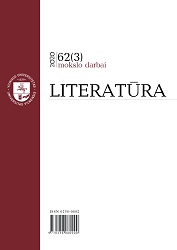Sãva ir svẽtima. Latinitas Lietuvos Didžiosios Kunigaikštystės tyrimuose
The Intrinsic and Extrinsic. Latinitas in the Research of the Grand Duchy of Lithuania
Author(s): Skirmantas KniežaSubject(s): Cultural history, Oral history, Social history, Sociolinguistics, Philology, Identity of Collectives
Published by: Vilniaus Universiteto Leidykla
Keywords: Latinitas; Latin language; Grand Duchy of Lithuania; Latin culture; Identity;
Summary/Abstract: This paper analyses the reception of Latin language and culture in the research of the Grand Duchy of Lithuania. It focuses on the works of various disciplines – social and cultural history, literary research, art criticism, etc. – and seeks to identify the recurring themes, symbols and topics that comprise homogenous narratives and interpretations. They consolidate the findings of different fields of study and thus allow to analyse the Latinitas of the Grand Duchy of Lithuania as an integral part of the political community’s identity. The symbols of Latin language and culture can be identified as a basis for a Shift from oral to written culture. It conveys the ideas of order and organisation, as it transforms customary law into a codified one, a natural religion into that based on Scripture, etc. It alters the society as well, mainly because writing and written culture marks a shift in identity and behaviour. Also, by focusing on social and educational aspects, the Shift marks an institutional change, which permeates the developments of the state and society as a whole. The multipolar cultural field of the Grand Duchy of Lithuania is described by four cultural models – Polish, Lithuanian, Ruthenian, and Latin. The metaphor of Interaction shows how Latin culture and language is seen as one of the four ideological alternatives that legitimize the state, dynasty and sovereignty. Thirdly, the metaphor of Tension depicts Latinitas as part of the dichotomy between Eastern and Western civilizations by expressing the symbolical content of the latter. This narrative also emphasizes the internal confessional disputes inside the Western Church, and by exploiting the specific understanding of the Renaissance humanism, it becomes a means to understand sociocultural conflicts of the Early Modern state. The interpretation of Latinitas as a communication channel is nested under the metaphor of Medium. Works in this category usually portray Latin language as an expression of a social, economic, political, etc. status quo, which differs in each European state. Latin culture thus helps to articulate national interests and identity, and enables the cultural exchange among the Western countries as well. Finally, by emphasizing the poor literacy of the society and only limited possibilities to learn Latin and acknowledge its cultural code, researchers portray Latinitas as a Secret. The speakers and writers of Latin form a hermetic group, possessing the knowledge of a cultural matrix inaccessible to others. The dignity of Latin language also strengthens the status of vernacular languages, and thus accumulates the process of identity formation. These five narratives exemplify how Latinitas is embedded within the economic, political, and cultural activities of the society. It also depicts the different ways by which it becomes an integrating principle of the identity of the intellectual and political classes in the Grand Duchy of Lithuania. It provides an account of Roman descent, sustains the claim for political sovereignty, and indicates the civilizing process. By adopting those five different narratives, researchers may further analyse Latinitas not only as a separate cultural layer, but as a part of social identity as well.
Journal: Literatūra
- Issue Year: 62/2020
- Issue No: 3
- Page Range: 93-110
- Page Count: 18
- Language: Lithuanian

